Light, jiggly, and fluffy, Japanese Cheesecake (Soufflé Cheesecake) is seriously the most delicious dessert to serve a crowd. It has the melt-in-your-mouth combination of creamy cheesecake and airy soufflé. A second serving (or more) is a guarantee!
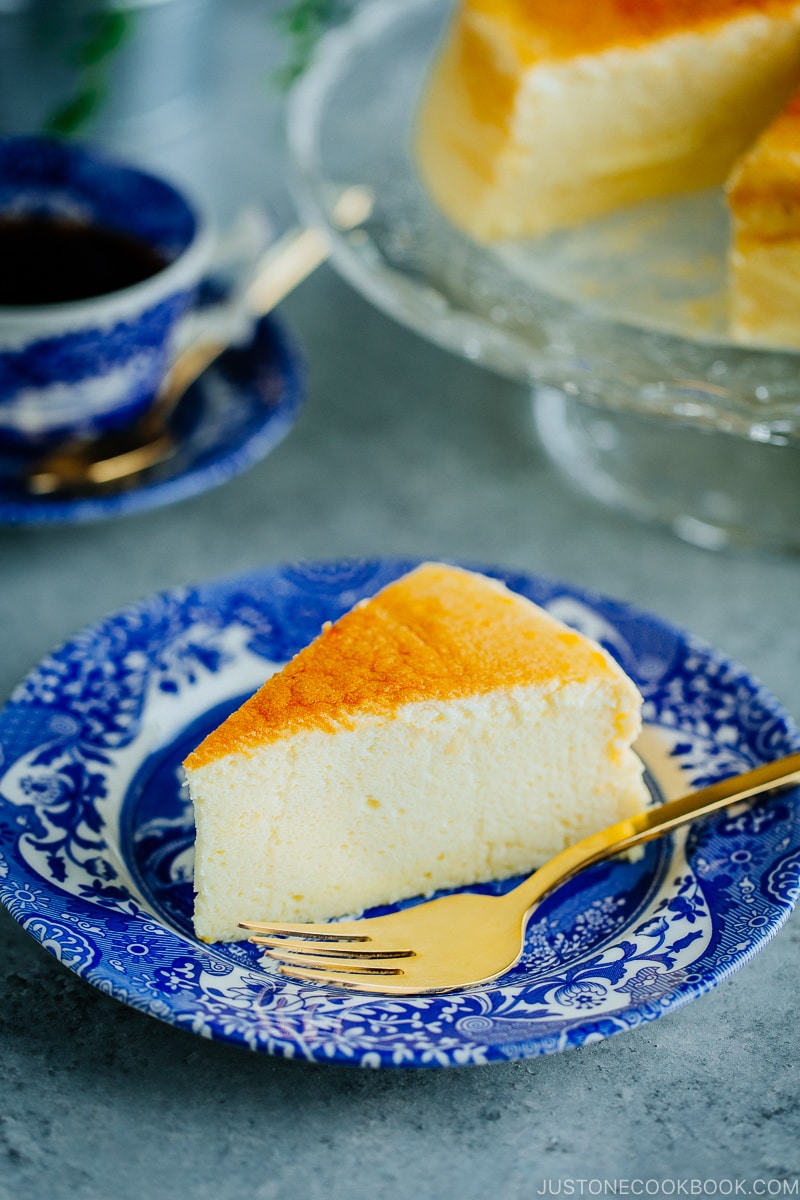
Japanese cheesecake (also goes by soufflé cheesecake) is a glorious dessert known for its ultra-creamy, super luxurious, slightly tangy flavor and airy, soufflé-like character. It has swept the food world by storm and almost every dessert fanatic goes wild for it.
Why is it so popular? What’s the difference between Japanese cheesecake and regular cheesecake? For a start, I think it has the ideal texture that appeals to everyone. With elements of both a rich velvety custard and a cottony sponge cake, the dessert simply hits all the right notes. It is not heavy and a lot less sweet than typical Western-style cheesecakes. Even those who are not into cheesecake will fall head over heels for this delicious treat.
Here, I’ll show you how to make the best Japanese cheesecake and we’ll cover these topics:
- What (exactly) is Japanese cheesecake
- A little background on cheesecakes in Japan
- Ingredients & equipment you’ll need
- Helpful tips & tricks
The recipe, while having several different steps, is simple enough to execute. Let’s get started!
What is Japanese Cheesecake?
This particular Japanese cheesecake recipe is a soufflé-style cheesecake that incorporates whipped egg whites in the cake mixture and is baked in a bain-marie (water bath), which results in its characteristically light and fluffy texture. Yes, it is basically the cheesecake version of the Japanese soufflé pancakes!
As there are a few varieties of cheesecakes in Japan, we call this cheese soufflé or soufflé cheesecake. Outside of Japan, however, it becomes synonymous with the generic “Japanese cheesecake”. Because of its unique texture, it is also called jiggly cake or Japanese cotton cheesecake. I agree, that’s a lot of names for a cheesecake!
Cheesecakes in Japan
While this has become the de facto ‘Japanese cheesecake’, I do want to mention that there are 3 main types of cheesecakes available in Japan:
- Baked cheesecake (ベイクドチーズケーキ)
- Rare cheesecake (レアチーズケーキ)
- Soufflé cheesecake (スフレチーズケーキ)
Baked cheesecake is the typical cheesecake. It has eggs, cream cheese, heavy cream, and flour and it’s baked in the oven. Some may have a biscuit crust on the bottom, and some don’t.
Rare cheesecake is the “no-bake cheesecake”. The cream cheese and heavy cream are mixed with gelatin or lemon juice, then poured over the biscuit crust, and cooled to set inside the refrigerator. Eggs are not used in this version. This type of cheesecake is often served with berries or other types of fruits.
Soufflé Cheesecake is the one we’re making today and originated in Japan. The technique is created by Yasui Juichi (安井寿一), a pastry chef at the patisserie of the Plaza Hotel.
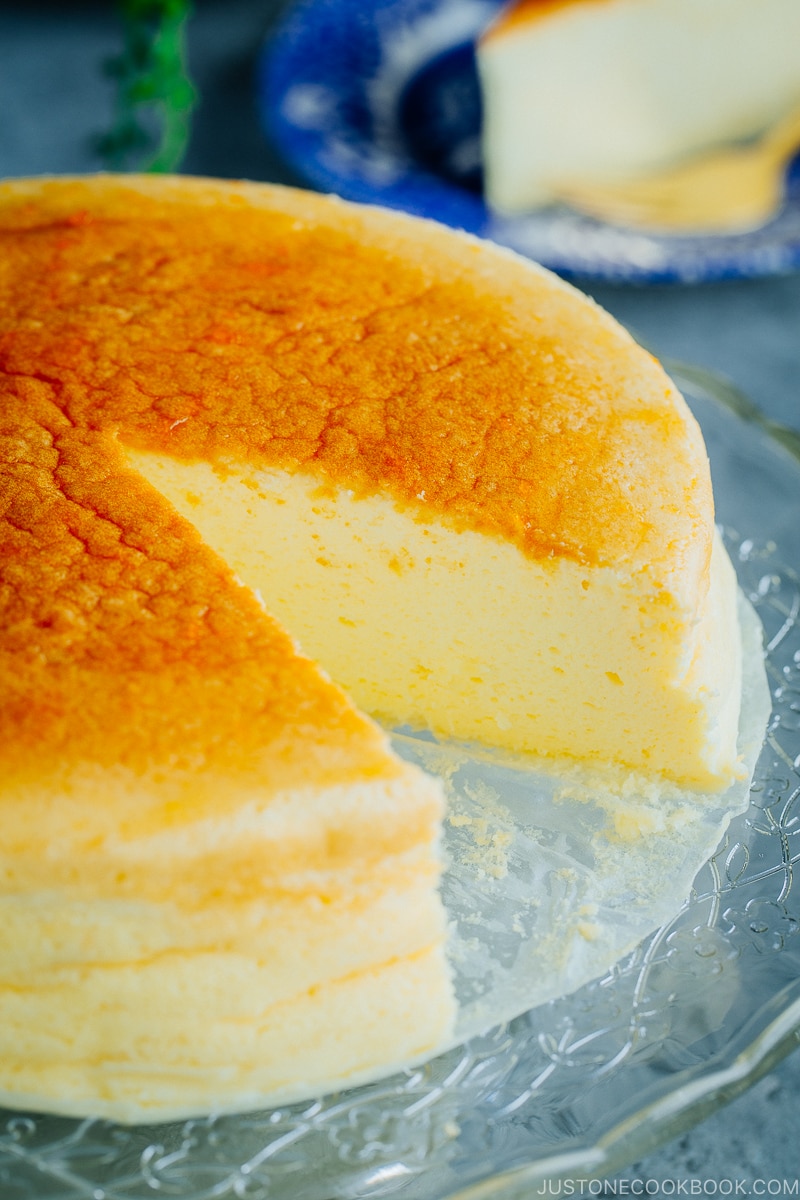
How to Make the Best Japanese Cheesecake
Ingredients You’ll Need
First, let’s go over the ingredients and equipment you will need to make this amazing cheesecake. I wrote this section so it’s helpful for beginner bakers. If you bake often, please skip this section.
1. Unsalted butter: When a baking recipe calls for unsalted butter or is written as just “butter”, that means the salt is not required. As baking is chemistry, I recommend using only unsalted butter.
2. Eggs: An American large egg is about 50 grams without shell (56.7 g with shell).
3. Cream Cheese: Buy two Philadelphia Original Cream Cheese 8 oz. boxes instead of the round container type. You will need one full box (8 oz.) and 2.5 oz. from the second box (there is the measurement on the package in case you don’t have a kitchen scale).
4. Heavy (Whipping) Cream: Heavy cream or heavy whipping cream is the richest type of liquid cream with a fat content of at least 36%. You can also go light and use whole milk in this recipe.
5. Granulated Sugar: I often receive questions about sugar whether you can use a substitute or reduce the amount of sugar. As I mentioned before, the amount of sugar affects the baking results. My recommendation is to follow the recipe first before adapting so you will know what works and what not. I use regular white granulated sugar for my baking unless stated otherwise.
6. Cake Flour: I use the King Arthur cake flour blend, but if you don’t have the cake flour in hand, you can always make it yourself. All you need is all-purpose flour and corn starch. To get 1 cup cake flour, take one level cup of all-purpose flour, remove 2 tablespoons, then add 2 tablespoons of corn starch back in, and sift to combine.
7. Lemon: To me, it’s important to include the lemon juice for a touch of tanginess and the zest for the fragrance.
8. Apricot Jam: Typical soufflé cheesecake is covered with apricot jam. It gives the right amount of tanginess and sweetness as well as a shiny sheer on the cake. I highly recommend getting a jar (my favorite brand is Bonne Maman).
Equipment You’ll Need
1. Cake Pan: I use this 9-inch cake pan with a 4-inch height. If your 9-inch cake pan is not 4-inch tall, you can still use it with parchment paper to support the rising cake. If you have a smaller or bigger cake pan, please adjust your ingredients as I used one egg as a unit of calculation.
- 1 large egg (50 g without shell)
- 50 g cream cheese
- 10 g unsalted butter
- 33 g (33 ml) heavy whipping cream
- 10 g granulated sugar
- 13 g cake flour
- 1 tsp. lemon juice + some zest
- 17 g granulated sugar for beating egg whites
I used to use a springform pan for my soufflé cheesecake, and most of the time I didn’t have any water seepage issues (I used a heavy-duty 8″ long aluminum foil to secure). However, I discovered a better solution (read below) with this new cake pan, so now I don’t use my springform pan for making this cheesecake.
2. Parchment Paper: You will need to pull out 30 inches of parchment paper. You will need one 30″ x 4″ (height of cake pan) sheet, and two 30″ x 2″ strips which are used to lift up the cake. To save time, I recommend this 9-inch round parchment paper liner for the bottom of the cake.
3. Mixing Bowls: You need 2 large mixing bowls for the cake batter, and a third one to beat egg whites (or a stand mixer bowl if using a stand mixer).
4. Fine Mesh Strainer: It’s important to sift the cake flour for the perfect texture. If you are going to make your own cake flour, then it’s even more important to have a fine-mesh strainer. We also use it to pass through the cake batter to achieve an extra refined texture.
5. Whisk: I use a whisk (I love this one) instead of a silicone spatula to incorporate air in the egg whites into the batter.
6. Stand Mixer or Electric Mixer: Have you beaten egg whites with your hand? It’s a real workout for your arm. I’ve done it before and let’s say I’m thankful for my stand mixer. You can use a hand mixer too; however, the speed level will be different, so trust your eyes.
7. Large Baking Sheet: You will need an oven-safe container to keep your 9-inch cake pan inside along with 1 inch of water. I use a large baking sheet.
Note: I know it looks like a lot to prepare, but these are basic things you’ll need for any baking. And you’ll definitely make this cheesecake more than once (because it’s so good)! Let’s talk about techniques next.
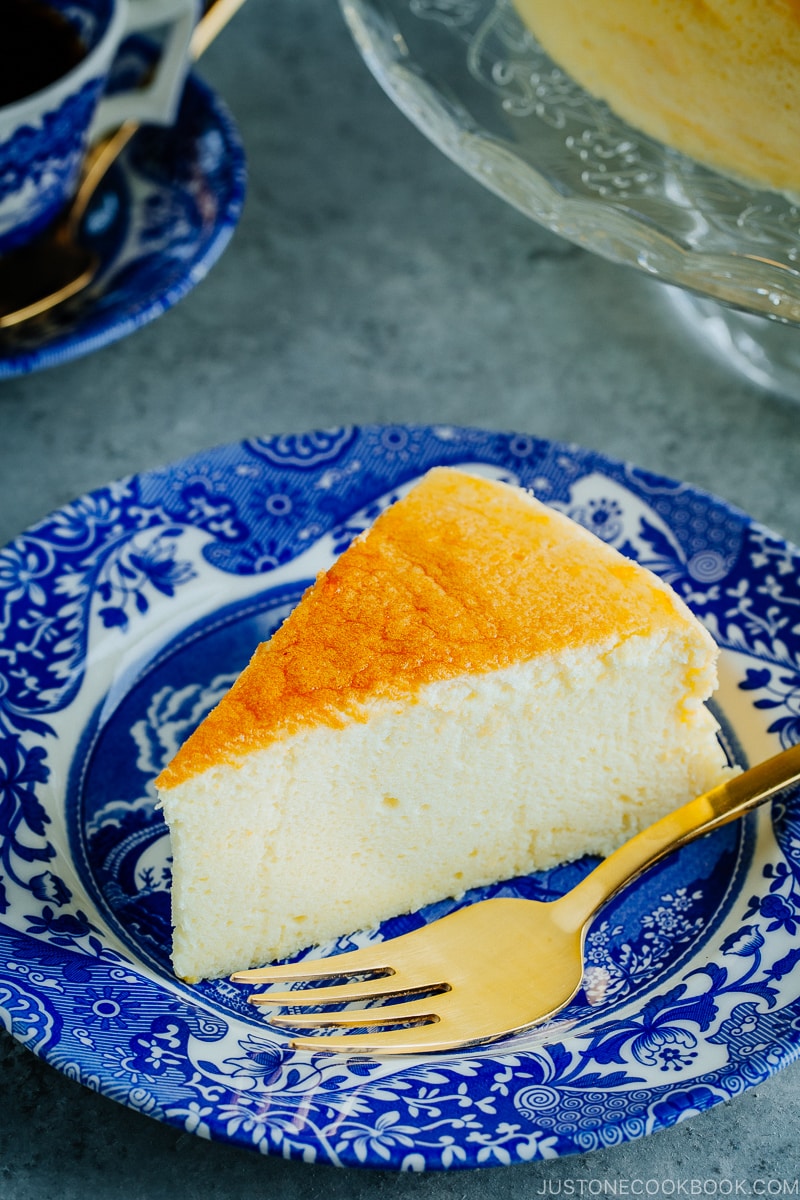
10 Helpful Tips to Bake Japanese Cheesecake
The instructions for this cheesecake are straightforward yet it does require some skills and care. The common difficulties include shrinking and cracking, which are mostly caused by the outcome of beating egg whites or the wrong oven temperature.
I had enough of my share of trials and errors before I finalized the recipe. So please take time to read through the tips and follow the directions closely so you’ll have a perfect outcome in your first try!
1. Measure Everything First

This sounds basic, but you must measure all the ingredients and prepare everything before you start making the cake.
Timing is very important here. Any missteps can easily alter the outcome of the cake batter and egg whites.
2. Make Parchment Paper “Strips”
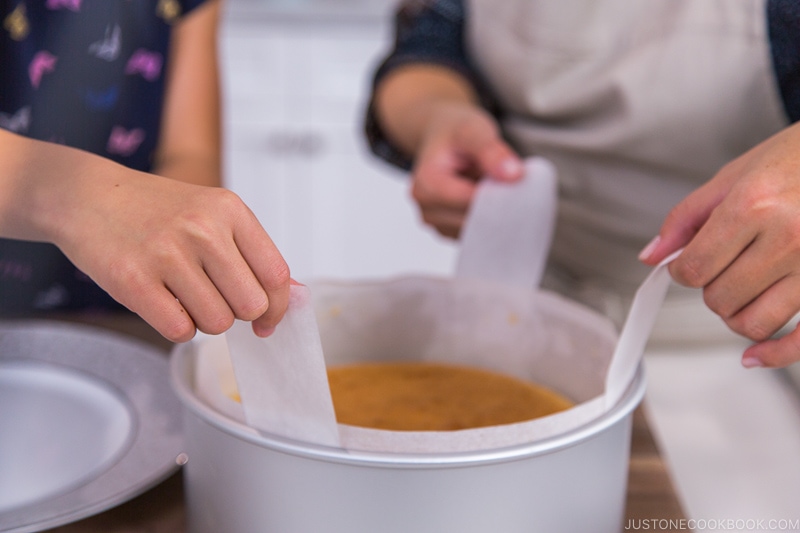
These strips of parchment paper are for pulling the cheesecake out of the cake pan after it comes out from the oven. Normally you will just flip and take the cake out, but it gets tricky for a cake with a jiggly, soufflé-like texture. With this trick, you don’t have to worry about the cake collapse on you.
3. Grease The Pan and Parchment Paper
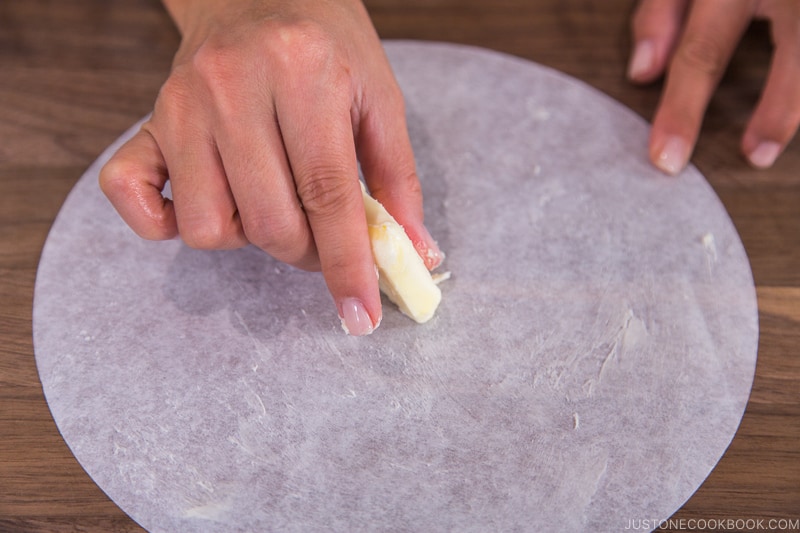
Grease the inside of the cake pan so that the parchment paper will stick to it nicely. And you will also need to grease the parchment paper that will touch the cake batter.
If the cheesecake is stuck with the parchment paper while rising, the cake will be pulled and end up cracking.
4. Use Double Boiler
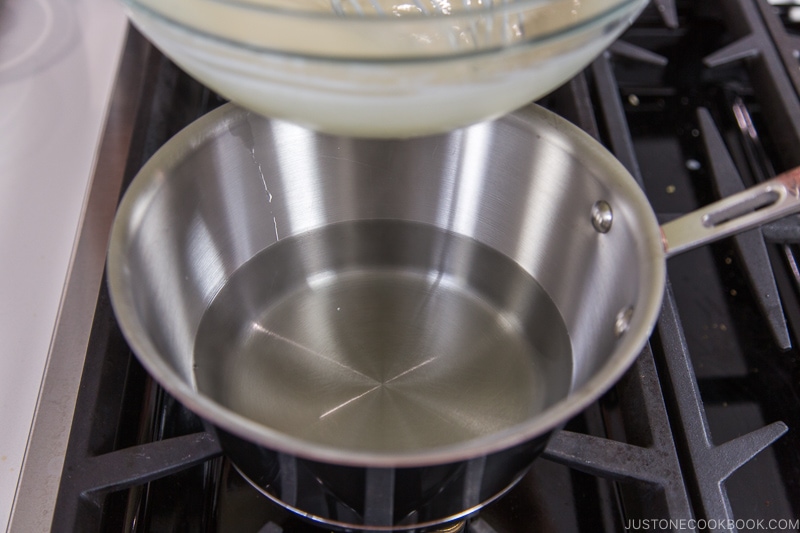
The double boiler method allows you to speed things up. You do NOT need to bring your ingredients (cream cheese, heavy cream, and egg yolks) to room temperature before making the cake!
Ingredients such as egg yolks mix better with the batter and rise more easily at room temperature. If you’re like me who tends to forget to take the ingredients out from the refrigerator ahead of time, you can count on a double boiler for mixing the batter.
5. Use Cold Egg Whites
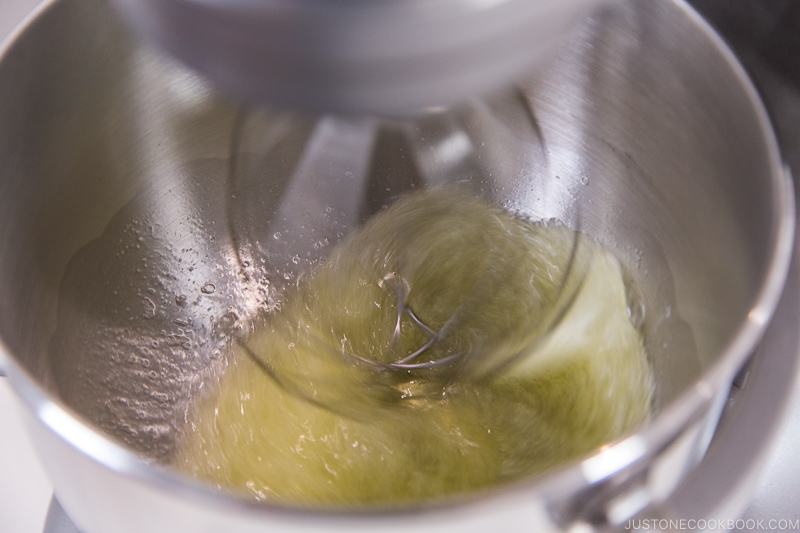
The Japanese method always uses cold egg whites (we even chill the bowl) to achieve a refined texture. I noticed American recipes call for room temperature egg whites to achieve the fullest volume instead. Maybe we look for different things? You can decide if you prefer cold or room temperature egg whites.
Some recipes call for cream of tartar but it is not a common product in Japan, so we do not use it for this recipe.
6. Beat Until a Firm Peak
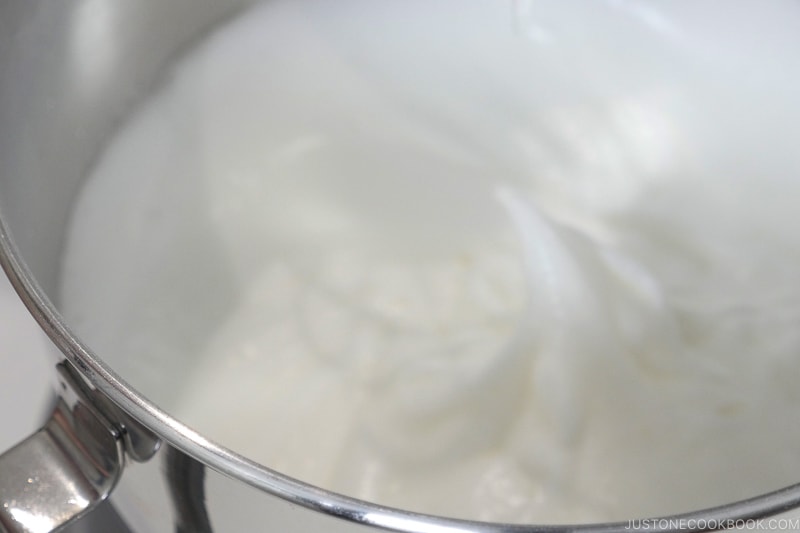
This is the most important (trickiest) part of making Japanese cheesecake. The beaten egg whites generate small air pockets in the structure of the cake, keeping the cake airy and fluffy.
When you beat egg whites, there are 3 stages: a soft, firm, and stiff peak. For this recipe, we are aiming for a firm peak.
When you lift the whisk and turn it upside down, the egg whites still cling to the whisk and hold their shape fairly well, but the tip of the peak folds back on itself.
I used to whip until a stiff peak formed and it worked fine. However, once in a while when I whipped a tiny bit too much, the cheesecake became a bit lopsided and cracked. Overall, it was a bit harder to control. Many soufflé cheesecake recipes in Japan call for both a firm peak or a stiff peak, so find what works for you, knowing this variable.
7. Fold in The Egg Whites
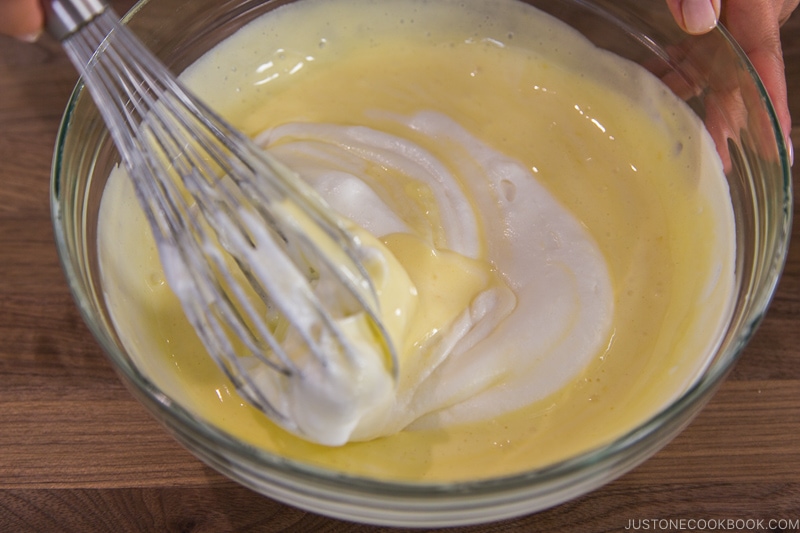
I learned that a whisk does a better job than a silicone spatula when you gently fold the egg whites into the batter. It’s very important to keep the small air bubbles so that the cake will rise higher without flopping.
8. Bake in Bain-Marie
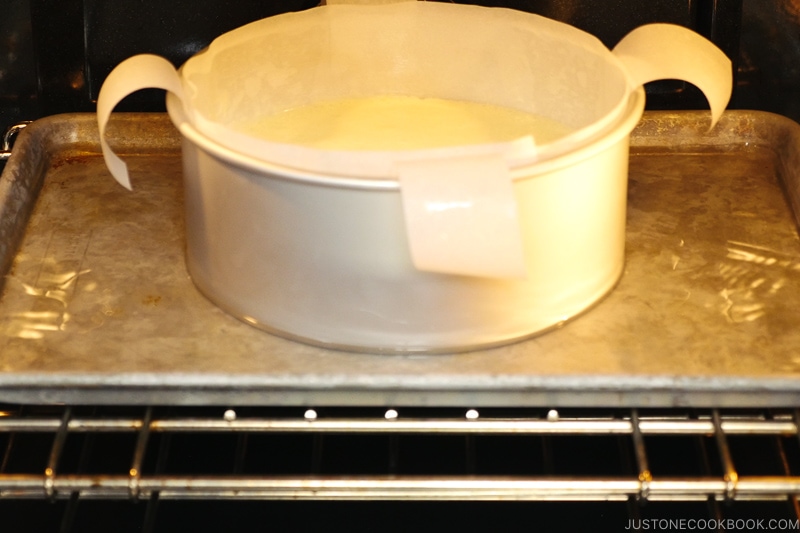
A bain-marie (ban mah-REE) is the fancy term for a water bath. We use this cooking technique to cook delicate foods like soufflé and custards. The hot water creates a gentle and uniform heat around the food as well as provides moisture inside the oven.
9. Bake at 2 Different Temperatures
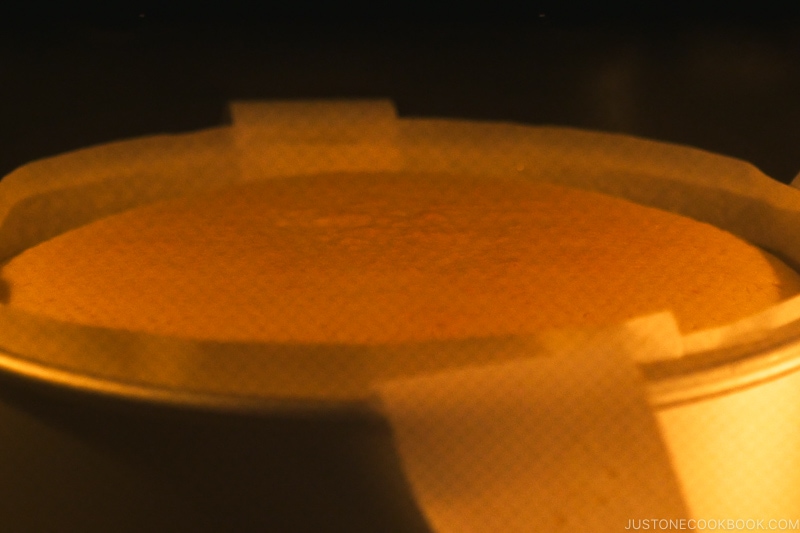
The oven temperature is probably the second most important factor for a successful Japanese cheesecake.
If the oven temperature is too high, the cheesecake will rise too fast, break the structure, and eventually crack. If the heat source is too close to the cake, the cake will also get big cracks. The taste will be fine, and after the cake cools down, the big cracks will be less obvious.
I preheat the oven to 350 ºF (180 ºC) first, but this is not the temperature for baking the cheesecake. Every time you open the oven to set up bain-marie or put the cake into the oven, the temperature drops significantly. Therefore we set the temperature higher.
Then when we put the cheesecake in the oven, we start baking at 320 ºF (160 ºC) and then reduce to 300 ºF (150 ºC) to make sure the cake is cooked through. My current oven is much bigger than my previous oven, and I had to test a few times to get the right baking time. If your oven is smaller than mine, you will probably need to reduce the baking time to 60 minutes. I have a “convection bake” option, but I used regular “bake” in this recipe so I could test the baking time for the majority of recipe users.
10. Cool Down Slowly
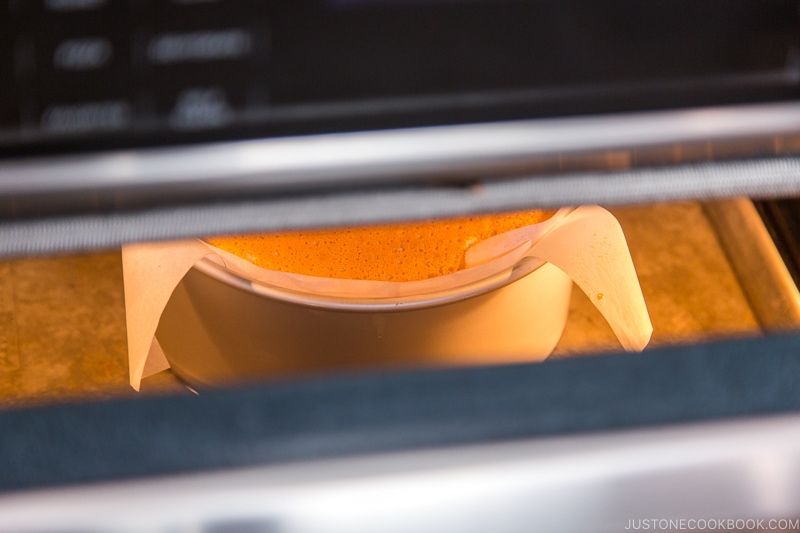
After baking in the oven, do not take out your cheesecake immediately. Let it cool down gradually by leaving the oven door ajar for a while.
This prevents a sudden change in temperature that could cause the cake to shrink or collapse. You want the cake to slowly come down to half the height, from 4 inches (tallest point) to 2 inches.
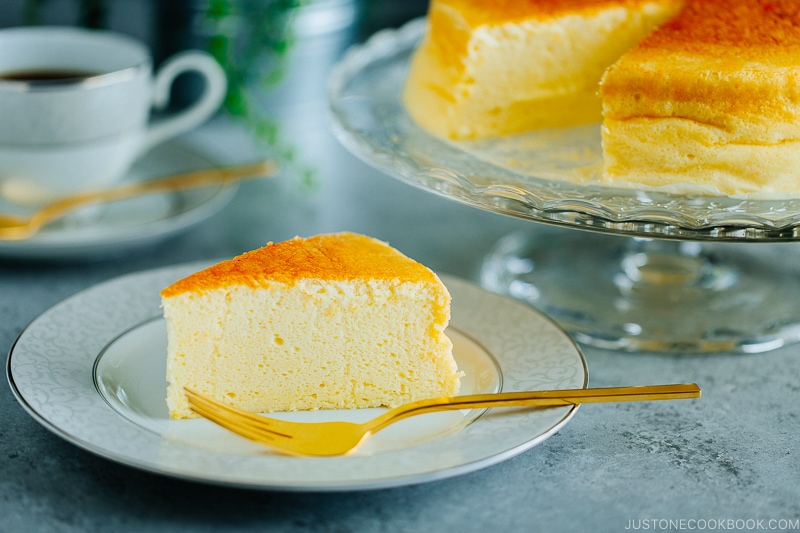
I’ve made the cheesecake countless times for parties or potlucks and it never fails to impress. It is truly a crowd-pleasing dessert that everyone loves. I hope you enjoy it too!
More Japanese Dessert Recipes You’ll Love
- Basque Burnt Cheesecake
- Matcha Basque Cheesecake
- Blueberry Cheesecake
- Pon de Ring Donuts
- Matcha Tiramisu
- Castella Cake (Honey Sponge Cake)
- Japanese Strawberry Shortcake
Disclaimer: In order to achieve the best SEO (search engine optimization) practice, we can no longer keep my original Japanese Cheesecake post (published on September 24, 2012) as it has the same recipe name as an updated version. Now the original post is redirected to this post. The original Cheesecake post has over 500 comments which will be very difficult for readers to go through when they look for an answer to similar questions they have. Therefore, we decided to create a brand new post. For those of you who really enjoyed my original Cheesecake recipe, you can still read the post by clicking here (and zooming in to read).
Wish to learn more about Japanese cooking? Sign up for our free newsletter to receive cooking tips & recipe updates! And stay in touch with me on Facebook, Pinterest, YouTube, and Instagram.
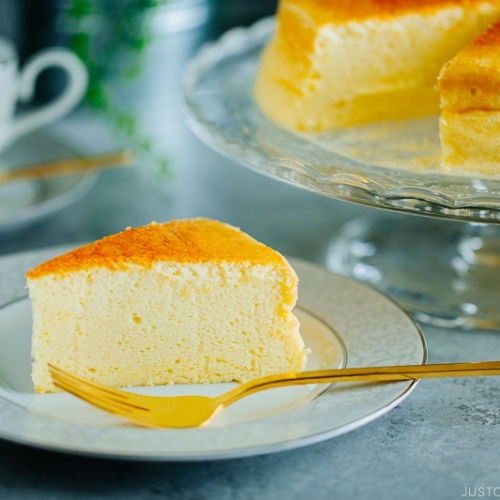
Japanese Cheesecake
Video
Ingredients
- 1 Tbsp unsalted butter (for greasing the pan and parchment paper)
- 6 large eggs (50 g each w/o shell) (10.6 oz, 300 g without shell)
- 10.6 oz cream cheese
- 4 Tbsp unsalted butter
- ¾ cup heavy (whipping) cream (¾ cup + 4 tsp, to be precise)
- 4½ Tbsp sugar (for the cream cheese mixture)
- ⅔ cup cake flour (weigh your flour or use the “fluff and sprinkle“ method and level it off; you can make your own Homemade Cake Flour)
- ½ lemon (for the zest)
- 2 Tbsp lemon juice (from ½ large lemon)
- ½ cup sugar (for beating the egg whites)
- 2 Tbsp apricot jam (for the glaze)
- 2 tsp hot water (for the glaze)
Instructions
Before You Start
- I highly encourage you to weigh your ingredients in metric using a kitchen scale for this recipe. Click on the “Metric“ button at the top of the recipe to convert the ingredient measurements to metric. If you‘re using a cup measurement, please follow the “fluff and sprinkle“ method: Fluff your flour with a spoon, sprinkle the flour into your measuring cup, and level it off. Otherwise, you may scoop more flour than you need. Please read the blog post for more detailed information that I shared about this recipe.
To Prepare the Cake Pan
- Use a 9-inch (23-cm) cake pan that is 4 inches (10 cm) high. Cut parchment paper to line the bottom and sides of the cake pan. Cut one circle 9 inches (23 cm) in diameter for the bottom and one rectangular strip 4 x 30 inches (10 x 76 cm) for the sides of the cake pan. In addition, cut two strips of paper 2 x 30 inches (5 x 76 cm) each. We will use these as “straps” to lift the baked cake from the pan.

- With 1 Tbsp unsalted butter, grease the cake pan and the parchment paper (for the bottom and the sides only; grease the paper on one side). You don‘t need to use all the butter.

- Place the two parchment paper “straps” crisscross on the bottom of the cake pan so they form an “X.” Allow the excess paper to hang over the sides. Then, line the bottom and sides with the greased parchment paper. The greased side of the paper circle should face up, and the greased side of the rectangular strip should face in toward the center of the pan.

To Preheat the Oven and Prepare a Double Boiler
- Preheat the oven to 350ºF (180ºC). For a convection oven, reduce the cooking temperature by 25ºF (15ºC). Note: You will be baking at 320ºF (160ºC). However, when you open the oven to place the cheesecake, you’ll lose some heat, so we’ll start off a bit higher.
- Prepare a double boiler: Set a medium saucepan filled with 2 inches (5 cm) of water over high heat and bring to a simmer. Once simmering, cover and reduce the heat to maintain a steady simmer.
To Gather the Ingredients
- Gather all the ingredients. Please note that it is very important to measure all your ingredients before starting. Separate 6 large eggs (50 g each w/o shell) into yolks and whites. Refrigerate the egg whites.

To Make the Cake Batter
- In a large bowl, add 10.6 oz cream cheese, 4 Tbsp unsalted butter, ¾ cup heavy (whipping) cream, and 4½ Tbsp sugar. Rest the bowl on the saucepan above the simmering water.

- Using a silicone spatula, mash the cream cheese and butter. Once they are melted, use a whisk to blend everything together. Remove from the heat.

- While whisking, add the egg yolks into the warm cream cheese mixture, one at a time. Make sure each yolk is blended well with the cream cheese mixture before adding the next one.

- Using a fine-mesh strainer, sift ⅔ cup cake flour into the batter. Whisk and blend together.

- Then, pass the batter through the same fine-mesh strainer into a clean large bowl. This creates a silky texture for the batter.

- Add the zest of ½ lemon into the batter. Make sure you only zest the flavorful yellow part and not the bitter white pith. Into a separate small bowl, squeeze the juice from the lemon. Measure 2 Tbsp lemon juice and add it to the batter. Whisk well to blend and set aside.

To Set Up the Bain-Marie
- Put the baking sheet inside the preheating oven and pour in hot water until it is halfway up the sides or ½ inch deep. Close the oven door.

To Beat and Incorporate the Egg Whites
- Add the cold egg whites into the dry, clean mixing bowl of a stand mixer. Make sure there is no oil or water in the bowl. If you have space in your refrigerator, I highly recommend keeping the mixing bowl cold until you’re ready to use it. Start whisking on medium speed (Speed 4) until the egg whites become opaque, foamy, and bubbly, about 2 minutes. Then, slowly add ½ cup sugar, one-third of it at a time, while the mixer runs.

- Once you’ve added all the sugar, increase the mixer speed to high (Speed 8–9) and beat the egg whites until you have firm peaks. When you lift the whisk and turn it upside down, the egg whites should still cling to the whisk and hold their shape fairly well, but the tip of the peak folds back on itself.

- Using a hand whisk, mix one-third of the egg whites into the cream cheese mixture until incorporated. Then, gently fold another one-third into the mixture.

- Lastly, pour the mixture back into the mixer bowl (with the last one-third of the egg whites still in it) and fold very gently until just combined.

- Pour the mixture into the cake pan all at once, avoiding air pockets while pouring. Tap the cake pan a few times on the kitchen counter to release any air pockets in the batter.

To Bake the Cheesecake
- Open the oven and place the cake pan onto the baking sheet with the bain-marie. Reduce the oven temperature to 320ºF (160ºC)—25ºF (15ºC) lower for a convection oven—and bake for 70–75 minutes. Then, reduce the oven temperature to 300ºF (150ºC) and bake for another 10 minutes, or until the top is golden brown. To test if the cake is done, open the oven door slightly and insert a skewer into the cake. If it comes out without a wet liquid batter, it‘s done.

To Cool
- Turn off the oven and leave the oven door slightly ajar for 15–20 minutes with the cake inside. If you take the cake out immediately to the kitchen counter, the sudden change in temperature could cause the cake to collapse. You want the cake to slowly shrink down to half the height, roughly from 4 inches to 2 inches high. After 15–20 minutes, remove the pan from the oven. Gently pull out the cake from the cake pan using the two parchment paper straps (with help from another set of hands).

- Place the cake on a plate. Remove the parchment paper around the sides of the cake (but leave the bottom paper). Combine 2 Tbsp apricot jam and 2 tsp hot water in a small bowl. Brush the apricot mixture over the top of the cheesecake. Let cool to room temperature.

To Serve
- You can serve the cake at room temperature (fluffiest!) or chill the cake for 1–2 hours before serving.

To Store
- You can store the cake in the refrigerator for up to 3–4 days or in the freezer for 3–4 weeks. Defrost the cake overnight in the refrigerator. The cold cheesecake is dense, so leave it on the counter until just chilled or at room temperature before serving.
Notes
- Make sure your beaters and mixing bowl are clean and dry. A speck of oil, water, or egg yolk on either one can minimize the volume of the beaten egg whites.
- Avoid plastic bowls—even clean ones may hold oily residue that can affect the successful whipping of the egg whites.
- Use a bowl that’s wide enough to keep the beaters from being buried in the egg whites.
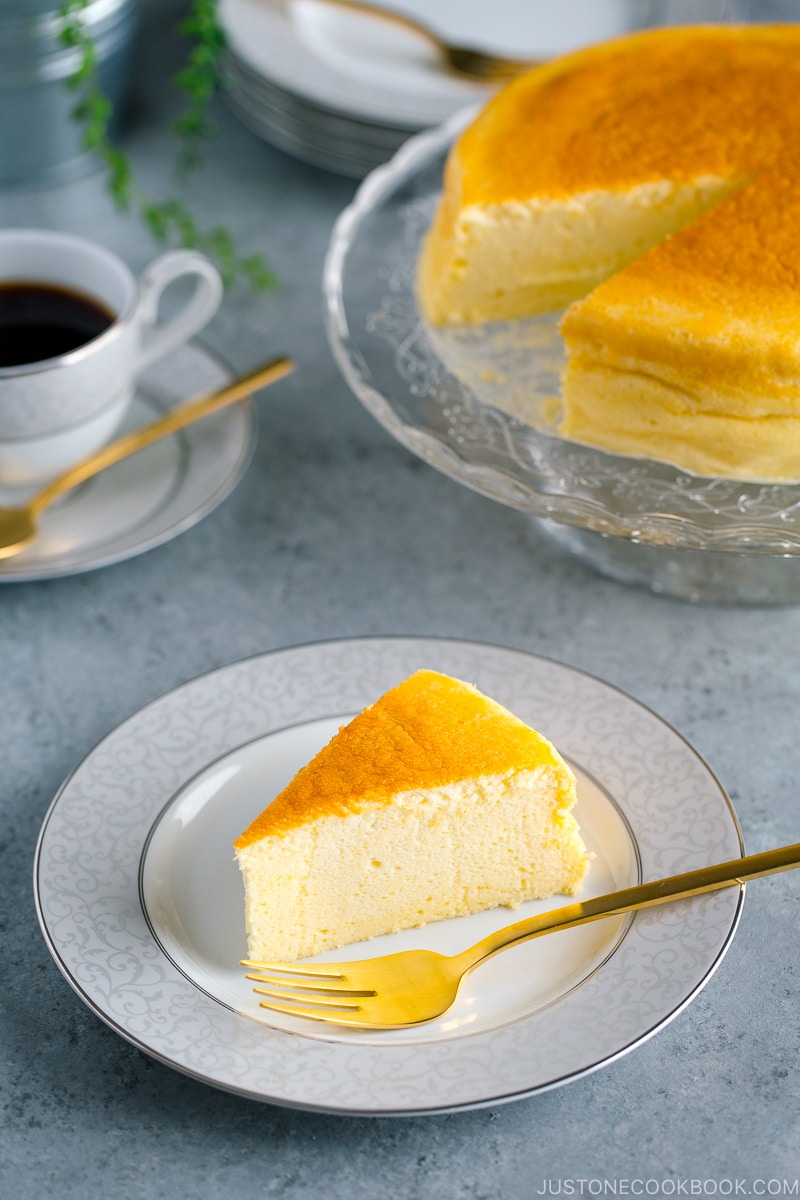
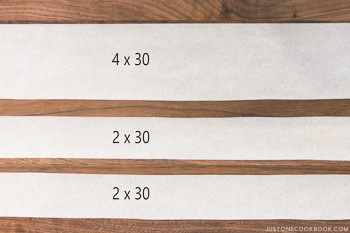

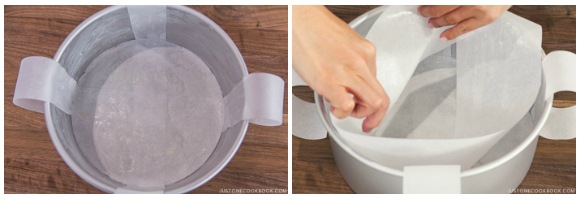
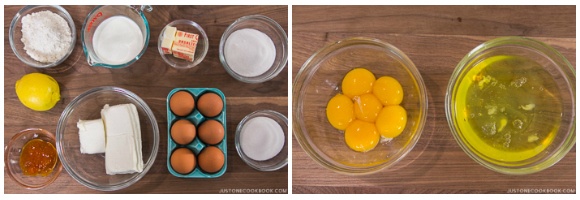
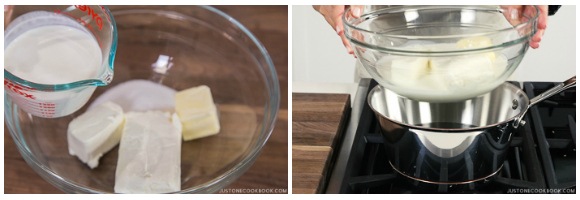
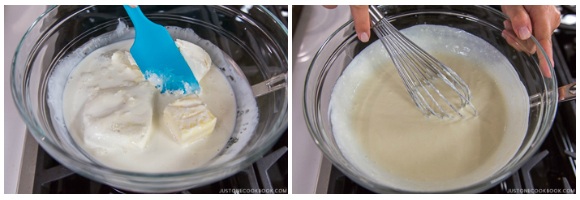
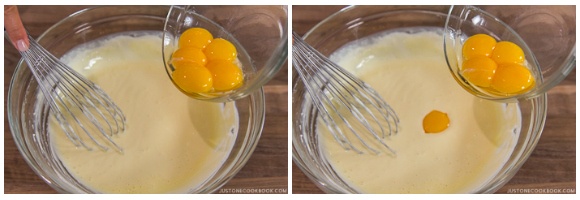

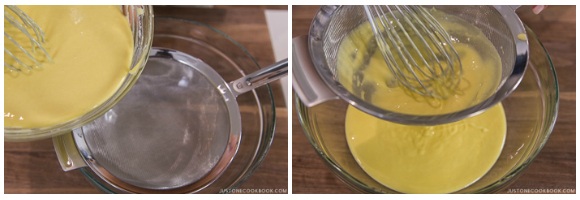

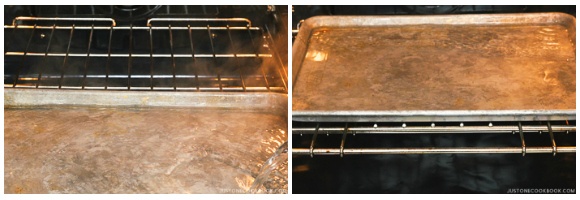

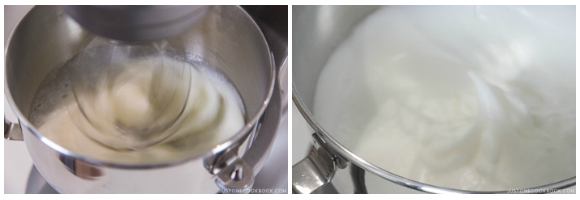
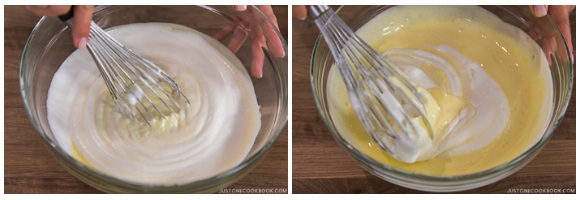
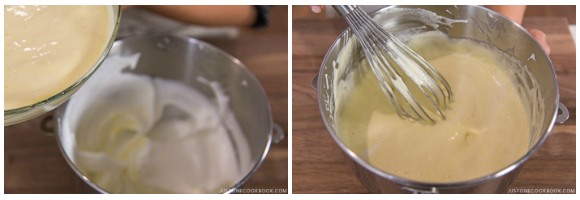
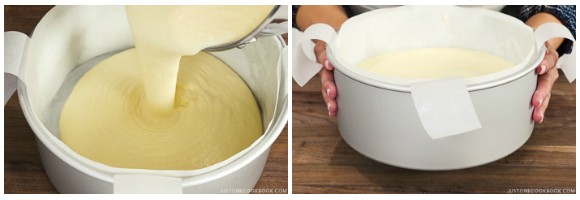

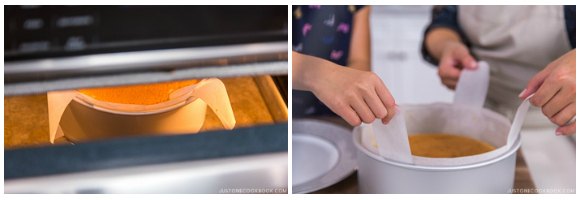

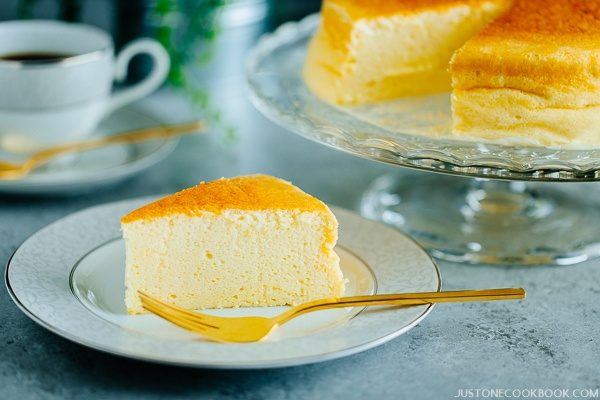

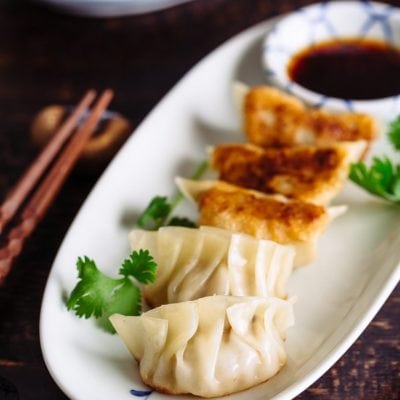
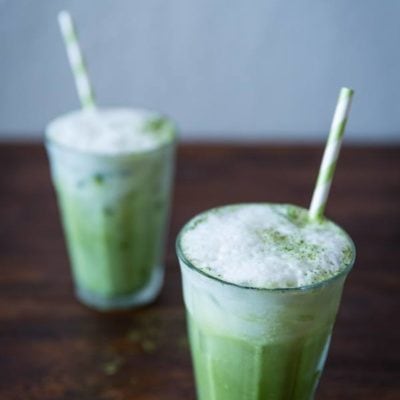
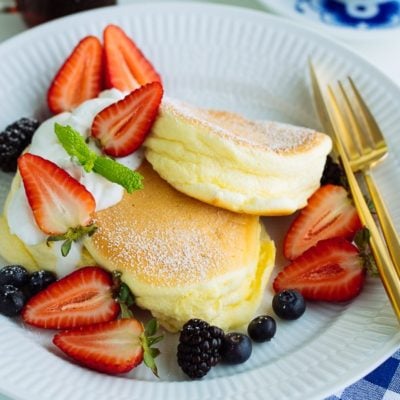
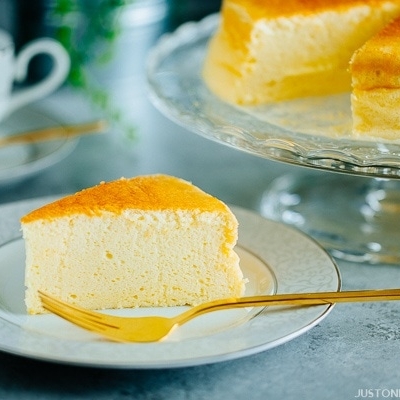
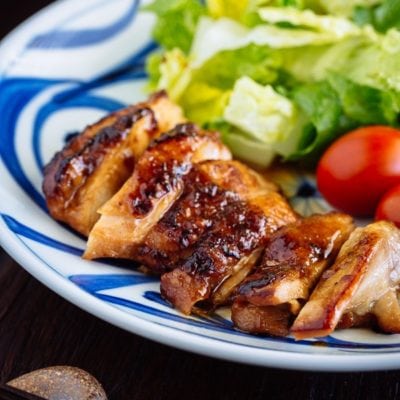


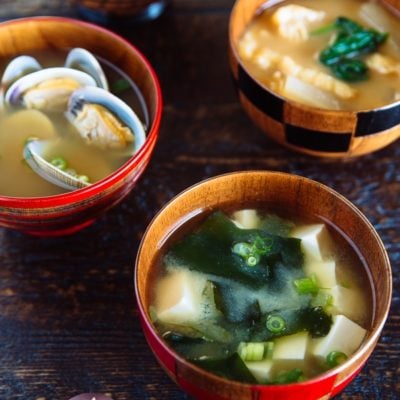


Thank you for the detailed instructions! I halved the recipe made it in a 6 inch spring form pan. It’s delicious – however, it cracked and after cooling the center is raised and there’s almost like a lower band on all sides. I wonder why that’s happened? I have a convection oven so I lowered the temperature by 15 degrees C as you mentioned. What can I do differently next time? Thank you
Hi, Van! Thank you very much for trying Nami’s recipe!
To prevent the crack, we recommend greasing the parchment paper more thoroughly in Step 2.
And let the cake cool gently by keeping the oven door slightly ajar.
We hope that this tip helps you on your next attempt. Happy baking!
Hi Nami,
I made this fabulous cake again today. This time, it came out even better and taller! Yes, I did use all the jam (unlike the first time!). I just wish it was more lemony. Thank you once again.
Hi Sofia! Thank you for trying Nami’s recipe again!
This turned out incredible! Will be making again and again.
Next time, I’d like to make it Ube flavored. Any idea how much Ube extract I would need to add and at what step? Thank you for sharing this fabulous recipe!
Hi, Alyssa! Thank you very much for trying Nami’s recipe!
We’re happy to hear you enjoyed the cake.
We’ve never made Ube flavored before, and we’re not sure how much extract we’d need to get the right balance. If we incorporate it into this recipe, step 6 will be the best.
If you try it, please let us know how it goes.
The recipe is great but my cheesecake doesn’t rise at all. I’m not sure what went wrong in the process
Hello, Gabriella! Thank you for trying Nami’s recipe and sharing your photos with us.
It appears that your cake dough was overmixed or that there was more flour than the recipe called for. Did you use a scale to weigh the flour? If not, we recommend it, particularly for the baking recipe.
We hope this helps!🙂
Thanks for your feedback. I don’t have cake flour at home so I had to mix AP flour and cornstarch together. Perhaps the proportions were off ?
But the cake is supposed to rise?
Hello, Gabriella. The cake will rise and become jiggly. However, as it cools, it shrinks slightly.
It’s possible that when you mixed the flour and cornstarch for this recipe and measured, it didn’t mix well.
this recipe was great! just tried it in a 8in springform pan. super jiggly and tastes amazing like uncle tetsu’s cheesecake!! no cracks or anything – came out perfectly. the only mishap i had was the water seeping in a little through the pan, so the bottom is a little denser (?). i’d try to do this with a pan similar to the one in the photos shown… but overall this is a very easy-to-follow and yummy recipe!!!!! :3
Hello, Wiwiey. Thank you for trying Nami’s recipe! We’re glad you enjoyed the jiggly cheesecake!
Nami used to use heavy-duty 8-inch-long aluminum foil to secure the springform pan. This method might work for you the next time.🙂
Hi your japanese cheesecake is the best. I tried the japanese cheesecake in different store but your recipe is the best one. I did it so many times. Can you suggest how many matcha powder need and for chocolate if I will do some variations. Do I need to reduce tbe flour if I will change the flavor. Thanks in advance
Hi Edz, Thank you very much for your thoughtful feedback. We are happy to learn that Nami’s cheesecake recipe is the best!☺️
You may modify this recipe by substituting matcha or cocoa for some of the flour.
We haven’t tried matcha, but some of our readers have, and combining 2-4 tablespoons (depending on how strong you like it) of matcha with a little water and adding it to the wet batter worked well. If you give it a try, please let us know how it goes!
Hi! Have you tried with an Italian meringue instead of French meringue with this cake? Thanks!
Hello, David. We’ve never used an Italian meringue in this recipe before.
Please let us know how it goes if you give it a try!
I’m so excited to try this, but do you have any heating recommendations for a 9 × 2 cake pan? I ordered my 9×4 today, but it won’t arrive for another week or 2. Should I cut the ingredients in half, or just lower the heating time?
Hi Savva, Thank you for trying Nami’s recipe.
If your 9-inch round cake pan is not 4 inches tall, you can still use it with 4 inches of parchment paper to support the rising cake.
We hope this helps!
I followed the recipe and baked it but it came out cracked and it didn’t rise that much
I preheated my oven at 350 for 30 minutes and lowered it to 320 and baked it for 73 minutes then at 300 until the top is golden brown. I let it cool in the oven. I did used a Bain Marie
I think it cracked while baking at 320 and somehow didn’t rise. Still good though
What did I do wrong?
Hello, Trong. Thank you for trying Nami’s recipe.
The majority of the cracks were caused by high temperatures inside the oven or by overbeating the meringue. Also, if there weren’t enough grease on the sidewall of the cake pan, the top would stretch out and crack. Have you tested the internal temperature of the oven? Even when the display shows the correct temperature, it occasionally goes off and requires adjusting.
We also recommend reading the part at the bottom of the recipe card titled Tips for Beating Egg Whites. These suggestions will assist you in avoiding a flat cake. We hope you find this information useful.😊
Hello Nami, thank you for sharing the recipe. I made it today and followed your recipe step by step. It worked. The cake came out almost just like the one in your picture! The only thing was that I used a 22.5 cm cake tin (and not quite tall) so for the sides parchment paper, I folded the paper into two to give an extra strength to support the rising cake.
The cake came out nice, and I brushed the top with diluted apricot jam but didn’t use all (I wasn’t sure if I had to use all!). The flavour was good and I could taste the lemon. It’s not a sweet cake but the apricot jam made all the difference. It’s a perfect match.
My question is – why is that the sides of the cake was/is quite pale? Could it be because of the parchment paper double thickness and height (I think it was about 6 inches total height)?
Hello, Sofia! We’re glad to hear you enjoyed Nami’s recipe.
Because of the thicker wall, it appears that your side of the cake did not receive as much heat as Nami’s, resulting in a different appearance. Next time, you can lengthen the baking time or raise the oven temperature a little if you like.
We hope this was helpful!
It turned out perfectly.
Hi Sandra! Yay! We are so happy to hear that. Thank you for trying Nami’s recipe!
Hi Nami,
I just made this recipe yesterday for maybe the 10th or 11th time? I can’t recall as I’ve been making it over 9 years now (not regularly lol) and I used to write to you and comment (I’m from Taiwan and was living in Italy) when your blog was a lot smaller. I still 100% rely on your recipes and notes to remind myself of what I need to do to make it as perfect as possible. Yesterday I made it for my international friends and one of them just said I _nailed it_ perfectly – I’m so grateful as I would never be able to share such wonderful things without your blog. My boyfriend’s family also had it before they met me – it was a great way to make a lovely impression. Thank you for making my life good with your recipes and help! Much appreciated and hope you and your Japanese-Taiwanese family are doing well! Can’t believe your kids are so old too, but guess that means I am too lol.
Love,
Catt
Hi Catt! Thank you so much for your love and support!❤️ Nami and all of us at JOC are so happy to hear you enjoyed Nami’s recipes.
We hope you continue to enjoy her recipes! Happy Cooking!
I first tried making this cake three years ago, and while the first try was a disaster (my pan leaked in the water bath so the cake basically became like a giant custard with a crust – still delicious, but not cake), it’s now become the house favourite and a huge hit with our neighbours and guests! I bake it in smaller pans and for less time, and skip the apricot glaze because everyone seems to really love the caramelised brown top.
The “paper airlift” is a lifesaver when getting the cake out of the pan, I wish it was practical to get smaller versions of these to work because I’d really love Japanese cheesecake in cupcake or muffin form someday but just can’t work out how to get the paper contraption to work in a cupcake tin.
Hi Nisha! Thank you so much for trying Nami’s recipe and sharing your baking experience with us!
We are so happy to hear this recipe has now become everyone’s favorite!
Regarding the cupcake size, how about using a cupcake liner instead of constructing them with parchment paper?
We are hoping that it will work for you.😉
Hey! I recently tried this recipe and almost everything went great. Look and texture were awesome. That being said the flavor was… eggy. I was wondering if you have some insight as to what I might be doing wrong? Thanks!
Hello, Matthew! Thank you for trying Nami’s recipe!
We’re delighted the recipe worked well for you!🤗
The eggy flavor might be due to the sort of egg. Some brands of eggs have strong egg smells, while others do not.
We recommend checking out several brands. We hope this was helpful!
Hi Nami! Thank you for sharing this detailed recipe. I’m thinking of making it into a kahlua coffee cheesecake, do you think this would work if I added some kahlua and coffee (maybe 4 tbsp total) in place of the lemon juice?
Thank you!
Hi Jo, Thank you so much for taking the time to read Nami’s post and experiment with her recipe!
We’ve never created coffee flavor before, and we’re not sure if it would be a nice flavor balance. If you are adding a total of 4 tablespoons, we recommend replacing the lemon juice (2 tablespoons) with additional 2 tablespoons of heavy (whipping) cream to balance out the liquid form in the recipe.
We hope this helps!